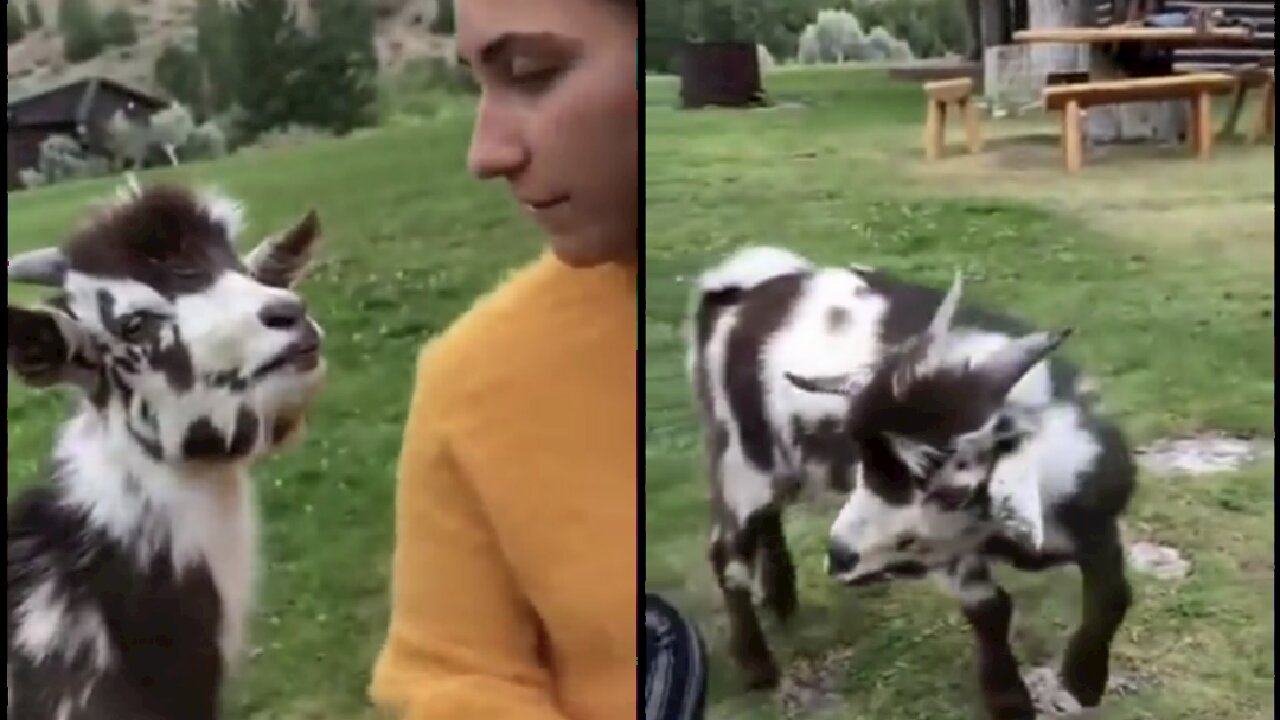Premium Only Content

Cute funny lamb fun with big girl and talk to her how sweet
Sheep are a prey species, and their only defense is to flee. Sheep display an intensely gregarious social instinct that allows them to bond closely to other sheep and preferentially to related flock members. ... Separation from the flock can cause stress and panic.
Sheep behavior
Behavior is one's response to its surroundings and circumstances. A understanding of sheep behavior is essential to making the raising and handling of sheep less stressful for both the sheep and shepherd. It will also dismiss the notion that sheep are a stupid animal.
Flocking behavior
Sheep are best known for their strong flocking (herding) and following instinct. They will run from what frightens them and band together in large groups for protection. This is the only protection they have from predators. There is safety in numbers. It is harder for a predator to pick a sheep out of a group than to go after a few strays. Flocking instinct varies by breed, with the fine wool breeds being the most gregarious. It is this strong flocking instinct that allows one person to look after so many sheep.
Follow the leader
When one sheep moves, the rest will follow, even if it does not seem to be a good idea. The flocking and following instinct of sheep is so strong that it caused the death of 400 sheep in 2006 in eastern Turkey. The sheep plunged to their death after one of the sheep tried to cross a 15-meter deep ravine, and the rest of the flock followed.
Even from birth, lambs learn to follow the older members of the flock. Ewes encourage their lambs to follow. The dominant members of the flock usually lead, followed by the submissive ones. If there is a ram in the flock, he usually leads.
Social
Sheep are very social animals. In a grazing situation, they need to see other sheep. In fact, ensuring that sheep always have visual contact with other sheep will prevent excess stress when moving, handling, or housing them. According to animal behaviorists, a group of five sheep is usually necessary for sheep to display their normal flocking behavior. A sheep will become highly-agitated if it is separated from the rest of the flock.
In addition to serving as a protection mechanism against predators, this flocking and following instinct enables humans to care for large numbers of sheep. It makes sheep easier to move or drive and enables a guardian dog to provide protection for a large flock. Domestication and thousands of generations of human contact has further strengthened this trait in sheep.
Domestication has also favored the non-aggressive, docile nature of sheep, making it easier for people, especially women and children, to care for sheep. Sheep were one of the earliest animals to be domesticated, and they have been thoroughly domesticated. It is doubtful they could survive in the wild, if a predator risk existed.
Sheep Senses
Senses are the tools that animals use to interact with their environment. Sheep and other animals share five basic senses: sight, sound, smell, taste, and touch. As a prey animal, sheep must have excellent senses to ensure their survival.
Sight
Sheep depend heavily upon their vision. Behavior scientists speculate that the placement and structure of the sheep's eyes are due to nature's designation of sheep as a prey animal. Sheep have a very large pupil that is somewhat rectangular in shape. The eyeball is placed more to the side of the head, which gives sheep a much wider field of vision. With only slight head movement, sheep are able to scan their surroundings. Their field of vision ranges from 191 to 306 degrees, depending upon the amount of wool on their face.
On the other hand, sheep have poor depth perception (three dimensional vision), especially if they are moving with their heads up. This is why they will often stop to examine something more closely. Sheep have difficulty picking out small details, such as an open space created by a partially opened gate. They tend to avoid shadows and sharp contrasts between light and dark. They are reluctant to go where they can't see.
For many years, it was believed that sheep and other livestock could not perceive color. But, it has since been proven that livestock possess the cones necessary for color vision. Research has shown that livestock can differentiate between colors, though their color perception is not equal to humans.
Hearing
Sheep have excellent hearing. They can amplify and pinpoint sound with their ears. In fact, sound arrives at each ear at a different time. Sheep are frightened by sudden loud noises, such as yelling or barking. In response to loud noises and other unnatural sounds, sheep become nervous and more difficult to handle. This is due to the release of stress-related hormones. To minimize stress, the handler should speak in a quiet, calm voice. Sheep should not be worked in the presence of barking dogs.
Smell
Sheep have an excellent sense of smell. Their olfactory system is more highly developed than humans. Sheep know what predators smell like. Smell helps rams locate ewes in heat. It helps ewes locate their lambs. Sheep use the sense of smell to locate water and detect differences in feed and pasture plants. Sheep are more likely to move into the wind than with the wind, so they can use their sense of smell.
Touch
Since most of their body is covered with wool or coarse hair, only the sheep's lips and mouth (and maybe ears) lend themselves well to feeling behavior. This is why electric wires on a fence need to be placed at nose height of the sheep. The sense of touch is important in the interaction between animals. Lambs seek bodily contact with their mothers. Ewes respond to this touching behavior in many ways (e.g. milk letdown). Groups of animals that have body contact remain calmer.
Taste
Sheep have the ability to differentiate feedstuffs and taste may play a role in this behavior. There is no evidence to suggest that sheep can balance their own ration when provided with a variety of feedstuffs; however, they may be able to seek out plants that make them feel better.
Normal sheep behavior
Changes in normal behavior can be an early sign of illness in sheep. The most obvious example of this relates to the sheep's most natural behavioral instinct, their flocking instinct. A sheep or lamb that is isolated from the rest of the flock is likely showing early signs of illness (unless it is lost). Even the last sheep through the gate should be suspected of not feeling well, especially if it is usually one of the first.
Appetite
Appetite is another strong indicator of health. Healthy sheep display normal eating and cud-chewing behavior. They will chew their cuds for several hours each day. Healthy sheep are eager to eat. They are almost always hungry. They will overeat, if we let them. Sheep bleat in anticipation of being fed and will rapidly approach the feeding area.
Lack of appetite is probably the most common symptom exhibited by a sick sheep. At the same time, food is an excellent motivator. Next to a good herding dog, a bucket of grain is usually the best way to gather and move sheep. Supplemental feeding tends to make sheep friendlier and less intimidated by people.
Sheep spend about fifteen percent of their time sleeping, but may lie down and rest at other times. Upon rising, they often defecate and stretch. A sheep that is reluctant to get up is probably in pain. A sheep takes a long time to lay down is probably in pain. A sheep that cannot relax is under stress. Teeth grinding is another common sign of pain in sheep.
Playful lambs
Healthy lambs nurse frequently, one to two times per hour during the first few weeks. A lamb that bleats all the time is probably hungry and not getting enough to eat. A healthy lamb usually stretches when it rises. Conversely, an unhealthy or hungry lambs often stands scrunched up. Healthy lambs sleep 8 to 12 hours per day. At nap time, they seek out their mothers and will sleep as close to her as possible.
Healthy lambs are usually very active. Group play is very common. Lambs love to climb. They are naturally curious of their surroundings. This curiosity can lead to barn yard accidents, if there are risks present. As lambs get older, they spend less time with their mothers and more with their peers. They spend more time foraging for food. Play wanes after about four months.
Watch out for rams
While sheep are generally docile, non-aggressive creatures, this is not necessarily the case with rams (intact males), especially during the breeding season (rut). Rams can be very aggressive and have been known to cause serious injuries, even death, to people. A ram should never be trusted, even if it is friendly or was raised as a pet. It is important to always know where the ram is and to never turn your back on him. Children and elderly should have restricted access to rams, especially during the breeding season.
Head butting is both a natural and learned behavior in sheep. Classic head butting among rams is highest during the rutting season which precedes the onset of heat in ewes. It is a way for rams to get into physical shape for the breeding season and to establish (or re-establish) the dominance hierarchy. To discourage butting, you should avoid petting or scratching a ram on the head. Otherwise, the ram may see this as a challenge or aggressive behavior. In general, the ram sees you as part of the flock and wants to dominate you.
While there are some strategies for dealing with aggressive rams, culling is usually the best option. Aggressive rams should be harvested for meat, not sold to other sheep producers. Rams, especially ones with horns, should not be kept as pets.
The only time ewes may exhibit agressive behavior is after lambing -- to protect their young.
-
 4:16:41
4:16:41
CatboyKami
5 hours agoStalker 2 Blind playthrough pt1
6.7K1 -
 1:06:27
1:06:27
Russell Brand
5 hours agoNeil Oliver on the Rise of Independent Media, Cultural Awakening & Fighting Centralized Power –SF498
171K249 -
 1:39:14
1:39:14
vivafrei
5 hours agoSoros Karma in New York! Tammy Duckwarth Spreads LIES About Tulsi Gabbard! Pennsylvania FLIPS & MORE
80.1K64 -
 1:57:36
1:57:36
The Charlie Kirk Show
5 hours agoInside the Transition + The Bathroom Battle + Ban Pharma Ads? | Rep. Mace, Tucker, Carr | 11.21.24
129K50 -
 59:20
59:20
The Dan Bongino Show
7 hours agoBitter CNN Goes After Me (Ep. 2375) - 11/21/2024
850K3.47K -
 57:28
57:28
TheMonicaCrowleyPodcast
2 hours agoThe Monica Crowley Podcast: Mandate into Action
16K2 -
 1:02:09
1:02:09
TheAlecLaceShow
5 hours agoGuests: Alex Marlow & Terry Schilling | Justice For Laken Riley | Russian ICBM | The Alec Lace Show
31K8 -
 1:51:15
1:51:15
Danny Haiphong
5 hours ago $10.82 earnedMARK SLEBODA & SCOTT RITTER: NATO ATTACKS RUSSIA, PUTIN FIRES ICBM WARNING SHOT AT UKRAINE—WW3 NEXT?
74.9K12 -
 40:47
40:47
Dave Portnoy
8 hours agoThe Unnamed Show With Dave Portnoy, Kirk Minihane, Ryan Whitney - Episode 37
55.8K2 -
 51:53
51:53
The Rubin Report
6 hours agoCrowd Shocked by Ben Affleck’s Unexpected Take on This Massive Change
96.5K70